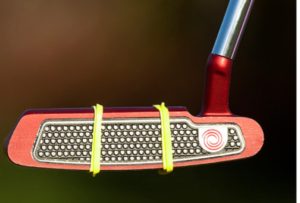

Lock Down Putting
During this difficult time where there is no golf being played, I thought it would be good to look at how we can help improve our game with out leaving our homes. There is no substitute for being out on the course or even the golf range but there are many drills we can work on without needing to smash driver 300 yards. For most club golfers the simplest and easiest way to lower scores is to hole more putts. In order to be considered a good putter you need to able to read the slope on the greens, control the speed the ball rolls and hit the ball on you intended start line. Well unless you have a putting green at home green reading will need to be a discussion for another time so first let’s look at your ability to start the ball on where you are aiming. The start line will be dictated by the direction of the swing and the clubface alignment at impact with the clubface being the most influential of these factors. In order to control the clubface in putting and for all our golf shots we must first hit the middle of the club or at least the same part of the face each time. If we hit random parts of the face the putter will twist creating random start lines, while also potentially changing the loft of the putter so the ball launches at different heights and at different speeds so creating distance control issues.
So, first on the carpet at home let’s just hit some random distance putts feeling the strike from the face to see if you can tell a difference. From here lets deliberately hit a putt from the toe of the putter then the heel of the putter to create an awareness of the desired feel. Now we have to built up this feel in our hands and our so brain we learn how to promote the desired centre strike. Get your putter and some elastic bands and wrap then around the face with a small gap in the middle to challenge you to strike some putts between these bands. (see picture 1) Start with a good gap between so you can achieve the centre strike then as you build confidence make the gap smaller to challenge your self to achieve this same strike. If you have the space make the swing bigger to see if you can achieve the strike with the more speed and movement going on. As you progress can you set up with your eyes open then close your eyes to see if you can strike the centre of the putter being aware of body movements from the feet then working up through your body. Understand we as human will always have variable movements from shot to shot as every moment is different but if we can reduce these variables, we increase the chances of hitting the centre of the putter.
Give this a try and get back to me with your thoughts and feedback.
Cheers
Dougie Bell
Update
The new World Handicap System officially launches today (November 2) for golfers in England, Wales, Scotland and Ireland, signalling the first major shift in handicapping across the country since the national handicap was introduced in 1911.
Developed by golf’s governing bodies – the R&A and USGA – the World Handicap System delivers one standardised system across all golfing nations and will now be used by golfers throughout Ireland, England, Scotland and Wales.
For the first time ever, golfers from these countries will be able to transport and use their ‘Handicap Index’ on any course around the world. The new Works Handicap System is designed to be a fairer and more equitable system of handicapping, as well as establishing a method for more accurately calculating a golfer’s current playing ability such as their form. As if a golfer who was off single figures at the start of the year and hasn’t been playing well for the last 20 rounds it will allow them to be able to play with a handicap that is suited to them at the minute.
The new handicap system works by accumulating the golfers best eight rounds out of the last 20 scores returned giving them their new handicap.
Personally I think this is a great thing to introduce to golfers in the UK and Ireland. It will really give a fair representation of golfers games on different courses. It will benefit the majority of golfers but I think specifically it will benefit the higher handicapped players as for an example, if they play open competitions in different courses, it will more than likely help them more at a course like Concrawood GC which is a long tough course compared to playing at smaller courses with lower standard scratches like Clover Hill or Ashfield.
Saying this it will still benefit all even the lower handicapped players as when they move to bigger courses an extra shot or 2 can really help them mentally as they feel like they’ve got a shot extra to play with. This will help especially if golfers make a mistake.
In conclusion I think it’s a good system to introduce to make the game a lot more equal, regardless of their handicaps.
The importance of short game in golf
In today’s game, from the PGA and European tour to the Sunday club golfers, the majority of golfers are hitting it a very long way due to their club head speed, new equipment and also by improving their physicality in the gym.
But a lot of golfers may wonder why they aren’t shooting low scores and fulfilling their potential, this is all down to their short game!
Have you ever heard the quote, “ drive for show, putt for dough”?
The majority of the golfers on the PGA and European tour, spend more time on the range practicing their shorter shots than longer ones.
Those who play for money know that the short game is where they are going to make it! Getting the ball close to those tight pin positions and making the putts is truly how to lower their scores.
Even with amateurs who have mid to low handicaps can always get the ball in and around the green of a par 4 in 2 shots, and then might take 3 or 4 shots from the edge of the green to get it into the hole.
By practicing your putting and chipping a lot more and by turning them 3 or 4 shots into 1 or 2, you won’t be long noticing a difference in your scorecards!
Jordan Spieth is known to be one of the best putters in the game, he ranked inside the top 10 in short game stats in 2013,2014 and 2019.
His putting practice routine is as follows:
20 straight line putts, this is to work on his starting line with the putter to make sure the face is square.
4 through to 9 feet putting drill around the hole, this is hitting different putts with different distances, slopes and pace. He sets a number of putts he has to hole before he can move onto the next drill.
10 foot putts, he then takes the ball back to 10 foot in the same drill and at each side of the hole he has to be four under par with 10 putts. So this means if he hits the ball longer or shorter than 2 feet of the hole it’s a bogey. A putt that missed the hole but is within 2 feet is a par and if he makes the putt it’s a birdie.
Spieth finishes with the ladder drill. This goes back to 15 foot putts and he has the goal of either making them or getting the ball within 2 feet. He used this drill to help get the pace right for the us open in chambers bay which really helped him to victory. He remembers being that dialed in that he got all the way back to 58 feet.
Definetely try some of these drills and if you learn anything from this, it’s that a lot more practice needs to be putt into short game as it’s not all about hitting 300 yard bombs and not being able to get a par or birdie from less than 100 yards into the pin.
Contact Information
Tel: North 07706937670 South 00447706937670
Email: info@golflessonsireland.com
Address: Kellys Golf Centre,
The Avenue,
Milltown Street,
Burren,
County Down,
BT34 3PS
Address Info
Greenlife Golf Range
Clermont Park,
Dublin Road,
Dundalk,
Co Louth
Address Info
Down Royal Park Golf Course
Lisburn
call today 07706937670
